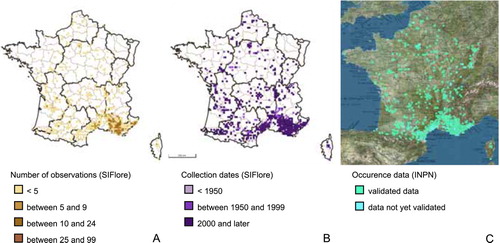Figures & data
Figure 1. Herbarium material providing data about the floral morph and the collection date and locality. (A) Herbarium specimen of Nigella damascena (barcode P02575070) presenting individuals from the [P] floral morph. (B) A focus on the most mature flower. The white arrows point at two of the petals. (C) A focus on the label showing the collection number, the determination provided by the collector, the collection locality and date, and the name of the collector. (D) A flower from the [T] morph, from the specimen P00195185. Digital images of both specimens can be downloaded using the following links: http://coldb.mnhn.fr/catalognumber/mnhn/p/p02575070 and http://coldb.mnhn.fr/catalognumber/mnhn/p/p00195185.
![Figure 1. Herbarium material providing data about the floral morph and the collection date and locality. (A) Herbarium specimen of Nigella damascena (barcode P02575070) presenting individuals from the [P] floral morph. (B) A focus on the most mature flower. The white arrows point at two of the petals. (C) A focus on the label showing the collection number, the determination provided by the collector, the collection locality and date, and the name of the collector. (D) A flower from the [T] morph, from the specimen P00195185. Digital images of both specimens can be downloaded using the following links: http://coldb.mnhn.fr/catalognumber/mnhn/p/p02575070 and http://coldb.mnhn.fr/catalognumber/mnhn/p/p00195185.](/cms/asset/10b55ad6-e163-489a-bdd6-c8b7263cdcda/tabg_a_1422437_f0001_oc.jpg)
Figure 2. Distribution area of Nigella damascena in France over the last two centuries, broken up in 50-year periods. (A–D) Distribution area of the [P] morph. (E–H) Distribution area of the [T] morph.
![Figure 2. Distribution area of Nigella damascena in France over the last two centuries, broken up in 50-year periods. (A–D) Distribution area of the [P] morph. (E–H) Distribution area of the [T] morph.](/cms/asset/5241671e-3e66-4237-85c0-04f4b6a58811/tabg_a_1422437_f0002_b.gif)

![Figure 3. Frequency of [P] and [T] morphs of Nigella damascena in a Museum time-series spanning two centuries. (A) Wild specimens. (B) Cultivated specimens.](/cms/asset/0bf989f9-a91e-4913-8534-fd5ef4e79bd1/tabg_a_1422437_f0003_b.gif)
